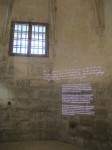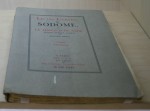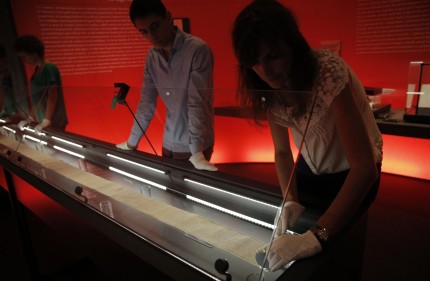 Donatien Alphonse François, Marquis de Sade, served a total of 32 years in prisons and insane asylums for transgressions that by the standards of ancien régime aristocrats were comparatively modest. His first prison stay (two weeks in 1763) in the donjon of the Châteaux de Vincennes was the result of a prostitute complaining not that he had abused her, but that he had engaged in and forced her to engage in blasphemies like stomping on a cross and cursing God.
Donatien Alphonse François, Marquis de Sade, served a total of 32 years in prisons and insane asylums for transgressions that by the standards of ancien régime aristocrats were comparatively modest. His first prison stay (two weeks in 1763) in the donjon of the Châteaux de Vincennes was the result of a prostitute complaining not that he had abused her, but that he had engaged in and forced her to engage in blasphemies like stomping on a cross and cursing God.
The second time he was arrested his victim was a destitute widow named Rose Keller who he had promised a job as a housekeeper. When she arrived at his home in Paris, there was no housekeeping job waiting. Instead, de Sade forced her to strip, whipped her and locked her in a room from which she escaped a few hours later. She also claim he cut her buttocks with a pen knife and poured sealing wax in the cuts, although when she was examined two days later the authorities found no cuts. For this crime he was imprisoned for seven months in 1768, before being banished to his family estate in La Coste, Provence.
 The third incident ultimately sealed his fate, but only because it pissed off the one person he should have taken special care not to piss off: his mother-in-law, Madame la Présidente de Montreuil. On June 23rd, 1772, de Sade had his valet Latour hire five prostitutes in Marseilles. The seven of them spent the morning whipping each other and having sex in various configurations. None of that was in any way remarkable. What went wrong was that the marquis tried to persuade the women to eat aniseed candies coated in Spanish fly. Only one of them ate any, but a sixth prostitute he hired that evening ingested several. Both of them became ill, with the evening shift women who had eaten the most becoming so violently ill that the last rites were administered.
The third incident ultimately sealed his fate, but only because it pissed off the one person he should have taken special care not to piss off: his mother-in-law, Madame la Présidente de Montreuil. On June 23rd, 1772, de Sade had his valet Latour hire five prostitutes in Marseilles. The seven of them spent the morning whipping each other and having sex in various configurations. None of that was in any way remarkable. What went wrong was that the marquis tried to persuade the women to eat aniseed candies coated in Spanish fly. Only one of them ate any, but a sixth prostitute he hired that evening ingested several. Both of them became ill, with the evening shift women who had eaten the most becoming so violently ill that the last rites were administered.
All six of the women were questioned by the police and a warrant was issued for the arrest of the Marquis de Sade and Latour for poisoning and for sodomy (with each other). The marquis was tipped off that the cops were after him again, so he fled to Italy taking his wife Renée-Pélagie’s sister Anne-Prospère de Launay with him. Sade was then 32; Anne-Prospère was just nineteen years old, 11 years younger than her sister, and was a secular canoness of the Benedictine community in Alix. La Présidente had fished her son-in-law’s overactive chestnuts out of the fire every time before this, but the seduction of her youngest daughter crossed a line that could not be uncrossed.
 Sade and Latour were tried in absentia, sentenced to death and burned in effigy. The marquis and his sister-in-law/lover traveled under assumed names to various cities in Italy for a month before Anne-Prospère left him and returned to her sister and mother. Because he was nothing if not reckless, Sade wrote to La Présidente mentioning that he was in Savoy. She promptly alerted the Savoyard authorities and the marquis and his valet were arrested and imprisoned in Fort Miolans. They escaped four months later and returned to La Coste where Sade’s unbelievably loyal wife protected him from her mother’s wrath and kept him just out of reach of the law’s long arm.
Sade and Latour were tried in absentia, sentenced to death and burned in effigy. The marquis and his sister-in-law/lover traveled under assumed names to various cities in Italy for a month before Anne-Prospère left him and returned to her sister and mother. Because he was nothing if not reckless, Sade wrote to La Présidente mentioning that he was in Savoy. She promptly alerted the Savoyard authorities and the marquis and his valet were arrested and imprisoned in Fort Miolans. They escaped four months later and returned to La Coste where Sade’s unbelievably loyal wife protected him from her mother’s wrath and kept him just out of reach of the law’s long arm.
After five years on the lam, he was lured to Paris on a pretext and arrested. He was imprisoned in the Château de Vincennes in 1777. It was the beginning of 13 years of imprisonment because even though his sentence was overturned on appeal in 1778, his formidable mother-in-law had obtained a lettre de cachet, the controversial means by which the king could order someone jailed without charge or trial indefinitely with no possibility of appeal, against him. Even when the liberal reformist zeal of the 1780s freed hundreds of disgraced debauched nobles imprisoned by lettres de cachet, the marquis was not among them. The official in charge read his letters for signs of repentance and found the polar opposite. Sade never did know when to keep his mouth shut.
 His first forays into prison literature were revisions of Italian travel notes, later published as Voyage d’Italie. He began to write verse plays a couple of years into his time in Vincennes. This was his original literary dream, to be a respected playwright. He wrote to his former teacher and lifelong friend Abbé Amblet in 1784: “It would doubtless be a great pleasure for me to see my works played in Paris and if they were successful, a reputation for being a man of intellect might perhaps lead people to forget my youthful trespasses and would in some way rehabilitate me.”
His first forays into prison literature were revisions of Italian travel notes, later published as Voyage d’Italie. He began to write verse plays a couple of years into his time in Vincennes. This was his original literary dream, to be a respected playwright. He wrote to his former teacher and lifelong friend Abbé Amblet in 1784: “It would doubtless be a great pleasure for me to see my works played in Paris and if they were successful, a reputation for being a man of intellect might perhaps lead people to forget my youthful trespasses and would in some way rehabilitate me.”
Sade was an incredibly prolific correspondent and wrote 20 plays during his imprisonment. When his long-suffering wife Pélagie and Amblet gave less than glowing critiques of most of them, the marquis eschewed verse and drama and turned his attentions to pornographic prose. He kicked off his new literary pursuit in high style and in a new location. On February 29th, 1784, he was dragged naked out of his cell in Vincennes and moved to another prison on the other side of Paris, a little place you might have heard of called the Bastille. It was there that he began to write what he would consider his masterpiece: The 120 Days of Sodom.
 To ensure this vomit-inducing catalogue of violent horrors and sexual depravity (I couldn’t get past the 9th day and it’s a walk in the park compared to what comes after) was not confiscated by his jailers, Sade wrote it in the tiniest of handwritings on sheets of paper five inches wide. Once he’d filled in a page, he’d glue it to the next page so the whole manuscript could be rolled up tightly and hidden in a crack in the wall (one biographer says he hid it in a dildo). He wrote for three hours a night over 37 days, producing a working draft of 250,000 words. The scroll was 39 feet long.
To ensure this vomit-inducing catalogue of violent horrors and sexual depravity (I couldn’t get past the 9th day and it’s a walk in the park compared to what comes after) was not confiscated by his jailers, Sade wrote it in the tiniest of handwritings on sheets of paper five inches wide. Once he’d filled in a page, he’d glue it to the next page so the whole manuscript could be rolled up tightly and hidden in a crack in the wall (one biographer says he hid it in a dildo). He wrote for three hours a night over 37 days, producing a working draft of 250,000 words. The scroll was 39 feet long.
 He intended the finished work to be twice or three times longer, but for unknown reasons he never did complete it. He certainly had the time. The Marquis de Sade was imprisoned in the Bastille for five years. He was abruptly transferred, naked again, from the Bastille to the insane asylum of Charenton on July 4th, 1789, 10 days before the fortress was so famously stormed. This too he brought on himself by yelling “They’re killing prisoners in here!” out of his window to the disgruntled crowds below on July 2nd. His precious scroll was left behind in the transfer and he assumed it was destroyed for good after the storming of the Bastille. In a 1790 letter to his steward Gaufridy, Sade said he shed “tears of blood” over the loss of of this manuscript and all his other writings (plus the expensive furniture, paintings and his library of 600 books) and blamed his poor wife for not recovering his belongings from his cell when she had 10 whole days to get it done.
He intended the finished work to be twice or three times longer, but for unknown reasons he never did complete it. He certainly had the time. The Marquis de Sade was imprisoned in the Bastille for five years. He was abruptly transferred, naked again, from the Bastille to the insane asylum of Charenton on July 4th, 1789, 10 days before the fortress was so famously stormed. This too he brought on himself by yelling “They’re killing prisoners in here!” out of his window to the disgruntled crowds below on July 2nd. His precious scroll was left behind in the transfer and he assumed it was destroyed for good after the storming of the Bastille. In a 1790 letter to his steward Gaufridy, Sade said he shed “tears of blood” over the loss of of this manuscript and all his other writings (plus the expensive furniture, paintings and his library of 600 books) and blamed his poor wife for not recovering his belongings from his cell when she had 10 whole days to get it done.
His first transit in Charenton lasted only a year; he was freed in 1790 when the French Revolutionary legislature abolished the lettre de cachet. He was elected to the National Convention that same year and served until he was arrested in late 1793 during the Reign of Terror for “moderatism.” Sade was freed seven months later in July of 1794 after the execution of Robespierre. Then Napoleon came along and he wanted a piece of the marquis too. In 1801 de Sade was arrested and imprisoned. Two years later his family had him declared insane and got him transferred back to the Charenton asylum where he would live out the rest of his days until his death in 1814.
 Many of his surviving papers and writings were destroyed by his son Donatien-Claude-Armand after his father’s death. He was the first in a long line of de Sades to repudiate their notorious ancestor’s writing and to erase all obvious signs of their family connection to him. They stopped using the Marquis de Sade title or even the first name Donatien for 300 years. (The current family has reversed the trend. They make significant bank off their notorious ancestor and the heir to the title is named Donatien.)
Many of his surviving papers and writings were destroyed by his son Donatien-Claude-Armand after his father’s death. He was the first in a long line of de Sades to repudiate their notorious ancestor’s writing and to erase all obvious signs of their family connection to him. They stopped using the Marquis de Sade title or even the first name Donatien for 300 years. (The current family has reversed the trend. They make significant bank off their notorious ancestor and the heir to the title is named Donatien.)
Although de Sade died believing his magnum opus was gone forever, in fact The 120 Days of Sodom had been found in its hidey hole by one Arnoux de Saint-Maximin who took it home with him two days before the storming of the Bastille. Eventually it was acquired by the wealthy Villeneuve-Trans family and it remained in their hands for three generations until it was sold in the late 19th century to Berlin psychiatrist Dr. Iwan Bloch, who published the first edition in 1904, 119 years after it was written. Bloch used the pseudonym Eugène Dühren to keep the censors off his case and printed 180 copies replete with transcription errors. Bloch emphasized that he was publishing the book because of its “scientific importance … to doctors, jurists and anthropologists” and compared its anecdotes to those recorded by pioneering psychiatrist Richard von Krafft-Ebing who was the first to popularize the term “sadism” in his seminal work Psychopathia Sexualis.
 The manuscript stayed in Berlin until 1929 when it was purchased by Maurice Heine at the behest of Viscount Charles de Noailles and his wife Marie-Laure who was a direct descendant of de Sade’s. Heine published a new version in three quarto volumes from 1931 to 1935 available to subscribers only. This is considered the authoritative version because it is free of Bloch’s transcription errors.
The manuscript stayed in Berlin until 1929 when it was purchased by Maurice Heine at the behest of Viscount Charles de Noailles and his wife Marie-Laure who was a direct descendant of de Sade’s. Heine published a new version in three quarto volumes from 1931 to 1935 available to subscribers only. This is considered the authoritative version because it is free of Bloch’s transcription errors.
The original scroll remained in the possession of the Vicount and Marie-Laure’s daughter Natalie de Noailles until 1982 when she entrusted it to someone she thought was a trusted friend, publisher Jean Grouet. He turned out to be a con man who told her it had been stolen while he smuggled the manuscript out of the country to Switzerland where he sold it to erotica collector Gérard Nordmann for $60,000. Natalie sued and in June of 1990, a French court ruled that the manuscript was stolen and should be returned to the Noailles family. Nordmann just ignored the French judgment and since Switzerland at that point was not a signatory of the UNESCO convention, Noailles had to sue again in the Swiss courts. The dispute was ongoing when Nordmann died in 1992. In 1998 a Swiss federal court found that it was lawfully acquired because Nordmann had acted “in good faith.” I mean, the Noailles had reported the theft to Interpol and everything. Why even have laws against theft if legal title can be transferred based only on the buyer’s supposed state of mind? Absurd.
 Anyway, it went on display for the first time in 2004 at the Martin Bodmer Foundation library and museum near Geneva. Nine years later, Nordmann’s heirs decided to sell the manuscript to a French collector. The Bibliothèque Nationale de France geared up for a fight, raising more than $5 million to purchase the scroll. The money would then be divided between the Noailles and Nordmann heirs, a necessary step because the manuscript would be confiscated as soon as it crossed the border into France unless the French courts declared the legal owners were part of the deal. Negotiations fell through and a year later, in April of 2014, it was bought by Gérard Lhéritier, founder of Aristophil, a company which owned the world’s largest private collection of manuscripts (including Napoleon and Josephine’s prenup), for seven million euros ($9.6 million).
Anyway, it went on display for the first time in 2004 at the Martin Bodmer Foundation library and museum near Geneva. Nine years later, Nordmann’s heirs decided to sell the manuscript to a French collector. The Bibliothèque Nationale de France geared up for a fight, raising more than $5 million to purchase the scroll. The money would then be divided between the Noailles and Nordmann heirs, a necessary step because the manuscript would be confiscated as soon as it crossed the border into France unless the French courts declared the legal owners were part of the deal. Negotiations fell through and a year later, in April of 2014, it was bought by Gérard Lhéritier, founder of Aristophil, a company which owned the world’s largest private collection of manuscripts (including Napoleon and Josephine’s prenup), for seven million euros ($9.6 million).
Lhéritier put the unfurled scroll on display at his private Museum of Letters and Manuscripts in Paris and proposed to donate it to the Bibliothèque Nationale after five years. The library didn’t respond immediately to his overtures. Seven months later, anti-fraud officers raided the Paris headquarters of Aristophil and froze all the company’s accounts forcing it into insolvency. The firm appears to have been a giant Ponzi scheme built around its historic document collection.
Lhéritier invented a new way to sell in his niche market. For the past 11 years, he has been actively purchasing valuable documents such as the manifesto of Surrealism by André Breton, Louis XVI’s will or Napoleon’s wedding certificate. He offered them for sale, divided into hundreds of shares. Clients were told that, after five years, Aristophil would buy back their share with at least a 40% interest payment. Here was the catch, claim the investigators: the clients thought the company was guaranteeing the payment; in fact, there was no obligation of the kind in the contract.
But in fact, the company has always done so, winning the confidence of 18,000 investors, who in the past year alone paid €160m for a share of the action. According to the judge’s order, of which The Art Newspaper has a copy, this was made possible only by launching new sales, so that new investors paid those selling their shares.
 In March of this year, Gérard Lhéritier, his daughter, his accountant and a prominent Parisian bookseller were indicted on charges including fraud, money laundering, creating false accounts and embezzlement. In August, a court in Paris ruled that the vast Astrophil collection was to be sold as the company was completely insolvent.
In March of this year, Gérard Lhéritier, his daughter, his accountant and a prominent Parisian bookseller were indicted on charges including fraud, money laundering, creating false accounts and embezzlement. In August, a court in Paris ruled that the vast Astrophil collection was to be sold as the company was completely insolvent.
And so it seems The 120 Days will be on the move again. Lhéritier denies all the charges and says the entire case is a government conspiracy to get its greedy mitts on his collection. Honestly, I hope it is, because otherwise those 135,000 documents will be scattered to the four winds unless the Bibliothèque Nationale de France’s director Bruno Racine manages to get the whole lot of them declared national treasure, which I expect he’s working on right now. At least the iconic The 120 Days of Sodom manuscript is certain to qualify. Then for the first time it will belong to the country which imprisoned its author under two kings, one Committee of Public Safety and one Consulate, and which banned his books until 1957.
